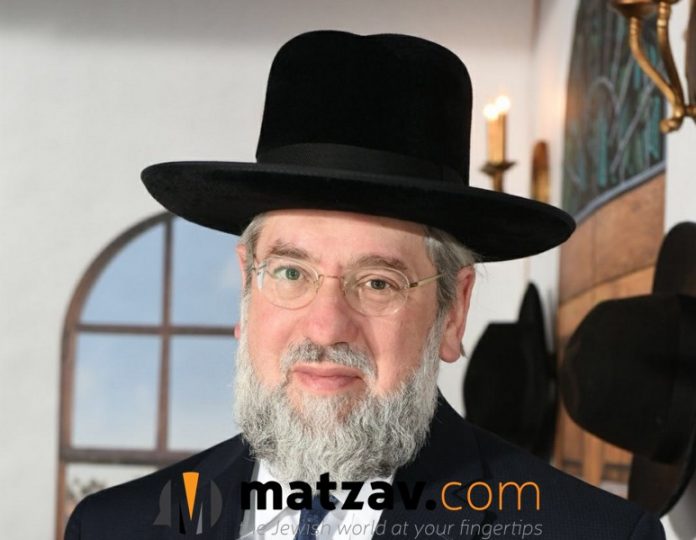
By Rabbi Pinchos Lipschutz
Sukkos, the Yom Tov that commands us to be fully joyous, as the posuk (Devorim 16:14-15) states, “Vesomachta bechagecha vehoyisa ach someiach,” is upon us. After the intense days of the Yomim Noraim, we look forward to the celebrative days of Sukkos. The kitchen is humming with action as the sukkah goes up, the children are busy coloring and decorating, and everyone is anticipating the welcome respite.
The Vilna Gaon famously expressed that the most difficult mitzvah of the Torah to observe is that of being happy on the eight days of Sukkos without having any sad thoughts or worries intruding.
I read the diary of a young man who learned in the Volozhiner Yeshiva. He writes gushingly about the joy of the Lithuanian Jews during Sukkos. I have excerpted a few paragraphs. Read along with me:
“The small towns of Lita were solemn a whole year round; there was no income and poverty was all they knew. But when Yom Tov arrived, old, dark bread was replaced with white bread, and everyone wore freshly cleaned clothing. Yom Tov brought a tremendous change. Everything was different. It felt like going from darkness to great light.
“During the Yom Tov of Sukkos, the town of Volozhin was adorned. All its inhabitants were swept up in celebration. The yeshiva bochurim sang and the school children danced around so merrily. From every corner of town, there was heard only much joy and happiness, as the town of Volozhin was overcome with rejoicing and festivity.
“The rest of the year, people were not overtly joyful, but when Yom Tov descended, they erupted in joy. Their natural inclination became one of jubilance and satisfaction. On Yom Tov, those very same people who were so serious all year sang and danced in blissful animation.
“This was true of all the Lithuanian shtetlach, but was most pronounced in Volozhin due to the presence of so many yeshiva bochurim. A whole year, they were in a different world, in the world of learning, but when Sukkos came, their inner happiness burst forth and they added even more to the city’s exultation.”
To enhance our joy, let us scratch beneath the surface of the mitzvah for which Sukkos is named. We hope that a greater, deeper understating and appreciation for the Yom Tov will increase our simcha during these days.
The Torah commands us (Vayikra 23:42-43) to dwell in a sukkah for seven days, beginning on the 15th day of Tishrei, “lemaan yeidu,” so that the generations will know that when Hashem took the Jews out of Mitzrayim, He gave them sukkos in which to live.
It is interesting to note that the Torah does not say that the mitzvah is to remember what took place at that time. Rather, the mitzvah is to know. Other mitzvos, such as tzitzis and Pesach, are to remember what happened, as the Torah states, “Lema’an tizkeru.” Why is the mitzvah of sukkah different?
The Tur (625) has a different question. He asks that the sukkah mentioned in the posuk (ibid.) refers to the Ananei Hakavod, which protected the Jews upon their exit from Mitzrayim. Why is the holiday of Sukkos commemorated during Tishrei and not during Nissan, the month the Jews left Mitzrayim?
The Vilna Gaon (Shir Hashirim 1:4) offers an answer. He writes that the Ananei Hakavod we commemorate on Sukkos is not the Holy Spirit that hovered over the Jews to protect them when they left Mitzrayim. If that was the reason for the celebration, the holiday would be marked during Nissan.
Rather, the sukkah commemorates that Hashem returned his Shechinah – via the Ananim – to the Jewish people following the sin of the Eigel. When the Jews sinned, Hashem removed His Shechinah and the Anan from among them. Moshe then returned to the mountain to plead for forgiveness. He descended on Yom Kippur. The next day, 11 Tishrei, he addressed the Bnei Yisroel and informed them of the mitzvah of constructing the Mishkon. He appealed to the people to donate the materials necessary to build the Mishkon, which would be the dwelling place of the Shechinah.
The Torah relates (“baboker baboker,” Shemos 36:3) that the people brought their donations for the next two days, the 12th and 13th of Tishrei. On the 14th of Tishrei, the builders of the Mishkon weighed, measured and accepted the gold and other materials from Moshe. On the 15th, they began to build. When the construction of the Mishkon commenced, the cloud returned.
Sukkos, says the Vilna Gaon, celebrates the return of the Shechinah cloud that was dependent on the construction of the Mishkon. That happened on the 15th of Tishrei, the day that begins the seven-day Yom Tov.
The Ramchal (Derech Hashem 4:7) states that on Sukkos, a remnant of the light of the original Ananim shines again. The influences that they affected in the midbar are manifest once again during the Sukkos period.
The Yalkut Shimoni (Emor 653) states that Hashem provides special protection for anyone who observes the mitzvah of sukkah. We can understand this based on the Ramchal that the power of the Ananei Hakavod is regenerated on Sukkos. Just as the Ananei Hakavod protected the Jews in the midbar from heat, cold, rain and sun, so too, on Sukkos, when we commemorate those miracles, the sukkah protects us from those who seek to hurt us.
The teaching of the Ramchal also helps us understand the statement quoted in Be’er Heiteiv (639:1) that observing the mitzvah of sukkah is akin to partnering with the Creator in the creation of the world.
Since, according the Vilna Gaon, we observe Sukkos in commemoration of the return of the Ananim to the encampment after the Bnei Yisroel repented for the sin of the Eigel. After we undergo the purifying process of Rosh Hashanah, the Aseres Yemei Teshuvah and Yom Kippur, we are then worthy of constructing our little Mishkon and meriting for the Holy Spirit to hover over the sukkah. Providing a resting place for the Shechinah in this world replicates the creation of the world, which provides a physical home for the Shechinah.
Sukkah is different than other mitzvos in that it is a mitzvah not only to sit in the sukkah, but to construct it as well. This is evident in the Rama (624:5), who says that those who are punctilious in their observance of mitzvos begin putting their sukkah together immediately after Yom Kippur, in order to go from one mitzvah to the next. In siman 625, the Rama states that it is a mitzvah to work on the sukkah right after Yom Kippur because of the rule that we perform a mitzvah when it comes our way – “mitzvah haba’ah leyodcha al tachmitzena.”
Some commentators say that it is derived from the posuk which states, “Chag hasukkos ta’aseh lecha – You shall make the Yom Tov of Sukkos” (Vayikra 23:41).
This phenomenon is not found with respect to other mitzvos. For example, we wear tefillin daily, but there is no specific commandment to produce them. There is no mitzvah to grow the lulav and esrog. Why is there a mitzvah to construct the sukkah?
We can understand the reason according to the explanation of the Vilna Gaon. Since when building a sukkah we are not simply constructing a room where we can eat and sleep, but also a holy place where we will be b’tzeila demehemnusa, we must purify ourselves and demonstrate proper dedication. That doesn’t happen by itself. It requires dedication and the purity that we achieve through the cleansing process Yom Kippur offers.
The Chofetz Chaim writes in his preface to sefer Chofetz Chaim that towards the end of the second Bais Hamikdosh period, sinas chinom and lashon hora spread, and because of that, the Bais Hamikdosh was destroyed and the Jewish people were dispersed into exile. He says that although the Gemara states that the people were beset by sinas chinom, in fact what is meant by that is that the senseless hatred led to lashon hora. Lashon hora is what caused the churban.
With this, we can understand the ruling of the Mishnah Berurah (639:2) that since the sukkah is a very holy place, Torah and holy matters should be discussed there and idle chatter should be minimized. Certainly, says the Mishnah Berurah, we must be careful not to speak lashon hora or rechilus there.
The sukkah, which commemorates the Ananei Hakavod, allows us to merit sitting b’tzeila demehemnusa, in the shadow of the Shechinah. Since lashon hora causes the Shechinah to depart, we are cautioned to abstain from speaking lashon hora in the sukkah.
This is also why the Ananim in the desert were in merit of Aharon Hakohein (Taanis 9a). Aharon loved and pursued peace, and worked to bring people together (Avos 1:12; see Netzach Yisroel 53-54). He engaged in activities that prevented strife and sinas chinom among the Jewish people, allowing the Ananim to stay, for the Shechinah only rests upon the Jewish people when they are united.
The Tur (417) writes that the Shalosh Regolim are connected to the three forefathers. Pesach is for Avrohom, Shavuos is for Yitzchok, and Sukkos is for Yaakov, regarding whom the posuk (Bereishis 33:17) states, “Ulimikneihu asah Sukkos – And for his animals he constructed sukkos.” The beginning of that posuk also states that after the confrontation with Eisov, Yaakov traveled to Sukkos. This is the complete posuk: “V’Yaakov nosa Sukkosa vayiven lo bayis ulimikneihu asah sukkos al kein kora sheim hamakom Sukkos.” The Zohar quotes the beginning of the posuk as the source that Sukkos is connected to Yaakov.
It is interesting that besides constructing sukkos, Yaakov consecrated the stone at the center of the Bais Hamkidosh known as the even shesiyah (Yoma 54b). The Medrash (Tanchuma, Terumah 9) teaches that when Yaakov went into exile in Mitzrayim, he brought trees that would later be harvested for their wood for the Mishkon.
Homiletically, Yaakov was engaging in the mitzvah of constructing a sukkah and mikdosh to the best of his abilities, since he lived many centuries before they were commanded. For us to benefit from them, it is incumbent to raise ourselves and participate in their construction.
To have the Shechinah in the sukkah, we have to work at it and prepare ourselves for the task. There can be no better time to work on the sukkah than after Rosh Hashanah and Yom Kippur.
Sukkos is Zeman Simchoseinu, our time of joy. For having been cleansed of our sins, we merit to sit b’tzeila demehemnusa, in the shadow of Hashem’s grace. Is there any greater joy?
Additionally, Sukkos foretells the End of Days, when we will be redeemed and merit the geulah sheleimah. The messianic period will usher in a time when we will repent, unite, and cease speaking lashon hora and engaging in other activities that cause division among the Jewish people.
When we act all year the way we conduct ourselves in the sukkah, we will merit the permanent return of the mikdosh and the Shechinah.












But I feel bad for the Non-Yidden whom Hashem is planning to trick them into running out of the Sukkah L’osid Lovoi. Why would Hashem, constantly, keep on creating Human Beings whom He is planning to trick; especially if He knows the outcome? Why would He create people in Asia that will never know of such a thing as a Yid and only be tricked L’osid Lovoi.? I asked my Rebbe these questions and he started yelling wildly.
Hashem gives every human being an opportunity to improve themselves and become a better, greater person. Rabbi Avigdor Miller z”l mentioned the gemora that says that the straight grass that went up and down without deviating in any direction was used to mark the boundaries of Israel and Yehoshua used it for this purpose. The gemora says that this grass prosecutes the robbers and cheats by providing an example of honest dealing.
Everyone is granted experiences and events in their lives which causes them to think about the meaning of life and hints at what the true way is. Most people ignore these hints and unfortunately do not advance. One example is a person who wanted to believe in Hashem and asked for a sign. Right then a truck with GOD on the side rolled by and this person viewed it as a sign.
The world has many examples for the nations to learn from as well as abundant Torah literature and talented and inciteful speakers and honest non Jews will learn from these things and advance. However, the world as a whole will brush off these things and sink into anti Semitic views which will distance themselves from the truth. The final test will be the succah test. The nations will be given one more chance once they have already seen the glory of the relationship between Hashem and the Jews and those that chose the wrong path will fail.
To tzoorba
That’s not what the Gemoroh says. All Non-Yidden will fail this difficult test. No choice.
Sd,
2 possibilities
The ones that are totally included with the nations at that time will have had their opportunities and have failed or when chazal say the umos they man the vast majority they don’t necessarily mean every single person.
ספר הישר לר”ת (חלק החידושים) סימן תרעה
כמו שעשו פושעי אומות העולם במצות סוכה כדאמרי’ בע”ז בתחילתו שכל אחד בועט בסוכתו. ואמרי’ (פושעין) [פשעים] אלו המרדין
It indicates poshei umos haolam which does not include everyone